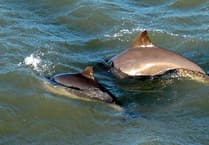A Pembrokeshire Coast National Park Authority project aims to remove and control the spread of invasive non-native species on land around rivers.
Recently the project has received funding to extend its work to six further locations.
The Stitch in Time project has been targeting invasive species such as Himalayan balsam in the Cwm Gwaun catchment since 2015 and has since expanded to include the Clydach and Porthgain catchments.
Having demonstrated that Himalayan balsam can be controlled at scale in these locations, the project has been granted more than £170,000 from the National Lottery Heritage Fund’s Nature Networks Fund, extending the project until 2025.
Project Co-ordinator, Matthew Tebbutt, who will lead and co-ordinate volunteers, community groups and contractors, staff and landowners said: “We are delighted to have secured this funding to extend the project’s impact to more areas of Pembrokeshire.
“The project will be aiming to extend and consolidate Himalayan balsam control in the selected areas, as well as controlling Japanese Knotweed where feasible.
As well as providing the blueprint for the next stages of the project, the work completed as part of the project since 2015 has enabled the National Park Authority to create a toolkit to share the catchment-based approach to Himalayan balsam management and the lessons learned along the way.”
The six protected areas that will be covered by the new phase of the project are: the Castlemartin Corse SSSI (Castlemartin Corse catchment) the Milford Haven Waterway SSSI (Holyland Wood and Pembroke Mill Pond), the Aberarth Carreg Wylan SSSI (Ceibwr, Moylegrove), the Preseli SAC and Cleddau Rivers SAC (Afon Wern), the Preseli SAC and North Pembrokeshire Woodlands SAC (Afon Nyfer- Crymych and Blaenffos headwaters and Brynberian sub-catchment) and the North West Pembrokeshire Commons SAC and St Davids SAC (Afon Alun St Davids).
To find out more about the Stitch in Time project visit www.pembrokeshirecoast.wales/stitch-in-time.




